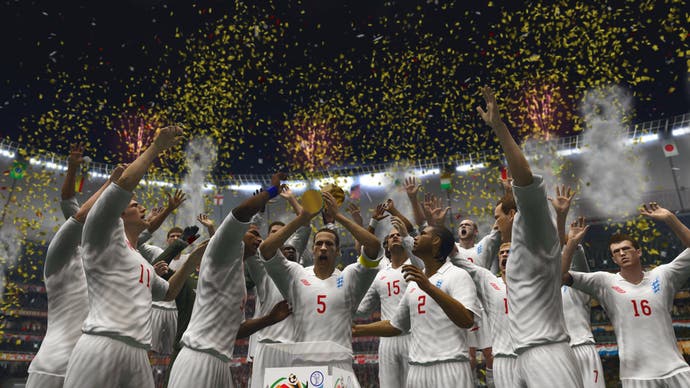2010 FIFA World Cup
Form is temporary, class is permanent.
With the world's biggest football tournament approaching like a juggernaut, it's comforting to know that, in the likelihood our national team fails to hold aloft the trophy, we can always play out our World Cup fantasies with EA's inevitable pre-tournament footy release. We caught up with 2010 FIFA World Cup's line producer Simon Humber to find out all the details he couldn't tell us last month and to get our hands on all-but-finished PS3 and Xbox 360 code.
Let's kick things off with the game's all-new optional two-button control system, which Humber believes will allow newcomers to jump in and start playing. "As well as the usual FIFA controls we've added an ability to play the game with two buttons," he explains. "We're calling it the Dad Pad as we hope it'll bring sons and fathers together to play."
The Dad Pad layout consists of one button to pass and one to shoot. The longer you hold down a button, the harder a shot or pass will be. As ever, player movement will be controlled with the left analog stick, while sprinting will be automated. While Humber and his team deserve kudos for giving greater accessibility a crack, the jury is still out as to whether a two-button greenhorn will be able to hold their own against a more adept player using a traditional FIFA button layout.
One of 2010 FIFA World Cup's biggest innovations is its revamped penalty system. "As you know, for many teams the World Cup comes down to penalties," laments Humber as he casts our minds back to England's wretched luck in shootouts.

"Our previous penalty system used a rock/paper/scissors mechanic. You'd just choose the direction, hold the stick to an extremity and hope the goalkeeper didn't choose the same direction. We wanted to implement a system that engaged gamers with a twitch mechanic that factored in how important the kick is. We wanted to make penalties feel really dramatic."
In theory, it all sounds rather good, but how does it actually work? Well, the more important a penalty, the harder it becomes to score it, due to the added pressure of the occasion. Take a spot kick when leading five-zilch in a backwater qualifier and your chances of rippling the net will be considerably higher than attempting to score the winning penalty in the World Cup final.
While Humber is keen to extol the virtues of the new system and the role played by pressure, in reality the new system boils down to a rather simplistic yet surprisingly tricky experience. Firstly, you have to stop an oscillating needle as close to the middle of a horizontal bar (aka the Green Zone) as possible. Once you've pressed shoot, you must hold it down to determine the strength of the kick. Your shot's direction is, as ever, controlled with the analog stick.
Now, perhaps it was just a balancing issue - one that as I type is being painstakingly tweaked by a team of gameplay boffins over in Vancouver - but both my opponent and I struggled to get to grips with the new system. Almost every penalty we took - of which there were many - either ended up spooning into the goalkeeper's hands or almost hitting the corner flag. Here's hoping the problem can be rectified before release.

